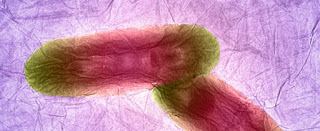A False Missing Link for Bacteria
Believers in molecules-to-microbiologist evolution are constantly looking for evidence to support their conjectures, and that includes links from allegedly simple to more advanced life forms. Some attempted to do that with prokaryotes and eukaryotes.
Remember from biology class that bacteria do not have a distinct nucleus, but eukaryotes are cells that have nuclei and form people, animals, plants and other things. These organisms are observed under a microscope, but one bacterium is huge in comparison to the rest. This bad boy is called Thiomargarita magnifica, but its aesthetic appeal is not exactly magnificent.
 |
| Nanographene oxide interacting with bacteria, TEM Wellcome Collection (CC BY 4.0) |
Some people call bacteria “simple,” but this is incorrect. All bacteria have very complex cellular systems, and some are even photosynthetic. In fact, many bacteria are symbionts (interreacting with plants and animals) and are essential to life on Earth.. . .There is nothing simple about this bacterium. Scientists “found the genome [the total genetic material within the cell] was huge, with 11 million bases harboring some 11,000 clearly distinguishable genes. Typically, bacterial genomes average about 4 million bases and about 3900 genes.”
To read it all, see "Big Bacterium—a Missing Link?"